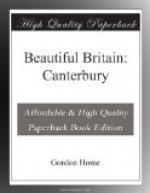When the Cathedral, the Abbey, and St. Martin’s Church have been visited, it is too often thought that Canterbury has yielded up all her treasures, but this is an amazingly mistaken idea. There still remain to be seen the Castle, the walls, the old inns, the many interesting examples of early domestic architecture, the remains of the lesser religious houses and hospitals, a wonderful array of interesting churches, and the excellent museum. Of the Castle the great Norman keep, completed about 1125, still stands, having been allowed to remain because the walls were found to be too hard to easily destroy; but up to the time of writing the Corporation has not purchased the immense shell, and it therefore remains a storage place for the coal of the adjoining gasworks. The remains of the buildings of the Black, or Preaching, Friars, and those of the Grey Friars, who belonged to the rule of St. Francis, are on islands formed by the Stour, and are marked in nearly every plan of the town. The hospitals include that of St. John the Baptist in North Gate Street, Eastbridge Hospital in St. Peter Street, and the Poor Priests’ Hospital near Stour Street. Outside the city, at Harbledown, is the interesting old Hospital of St. Nicholas, a home for lepers, who were separately housed.
Of the churches it would be easy to write a great deal, but there is merely space to point out that the only one lacking in interest is All Saints’ in High Street. At St. Dunstan’s the head of Sir Thomas More is preserved in a vault, but it is never possible to see it, and one must be content with the picturesque brick gateway of the Roper house in St. Dunstan’s Street.
[Illustration: Plan of Canterbury castle.
Key to numbers.
1. Door to Cloisters.
2. Door In Cloisters.
3. Dean’s (or Lady) Chapel.
4. St. Michael’s Chapel.
5. Baptistery.
6. Library (Howleian).
7. Treasury.
8. Chapel of King Henry IV.
9. Arundel Tower (N.W.).
10. Dunstan Tower (S.W.).
11. Entrance to French Church.
12. Archbishop Benson.
13. Bishop Parry.
14. Archbishop Sumner.
15. Sir T. Hales.
16. Colonel Stuart.
17. Dr. Beaney.
18. Dean Fotherbye.
19. Archbishop Chicheley.
20. Archbishop Bourchier.
21. Archbishop Kemp.
22. Archbishop Sudbury.
23. St. Dunstan (site).
24. Archbishop Tait.
25. King Henry IV.
26. Edward, the Black Prince.
27. Becket’s Shrine (site).
28. Cardinal Pole.
29. Unknown.
30. Archbishop Mepham.
31. Archbishop Winchelsey.
32. Henry de Estria.
33. Stephen Langton.
34. Archbishop’s ancient Chair.
35. Memorial to Dean Farrar.
36. Wm. Broughton, Bishop of Sydney
and Adelaide.
37. Archbishop Boyes.
38. Tomb of Dean Farrar.
39. Tomb of Archbishop Temple.
40. Two columns from Reculver.]




